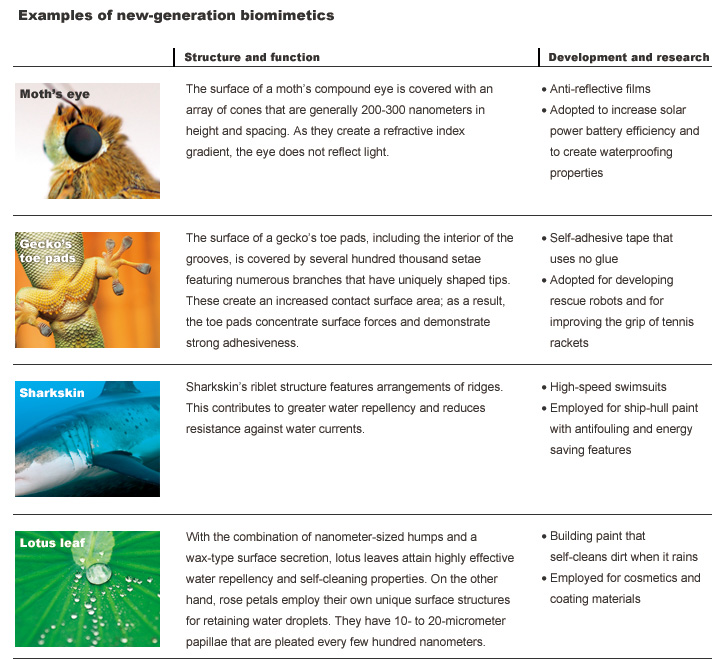
Humans have a huge “energy footprint.” We consume massive amounts of energy in virtually everything we do, from feeding ourselves to manufacturing the products that drive our societies. But what if we could adopt certain energy-efficient characteristics of plants and animals? What if we could recreate some of the intricate microstructures that endow them with incredible abilities? This is precisely the goal of researchers working in the fascinating realm of biomimetics.
New possibilities from an old idea
The term biomimetics derives from the Greek words bios, or “life,” and mimesis, “to imitate.” Put simply, biomimetics means to apply designs from nature to solve problems in engineering, material science and other fields.
The term was coined in the 1950s by Otto Schmitt, an American biophysicist who engineered an electronic circuit that mimicked nerve systems in squid. The practice of biomimetics, however, dates to 1935, when nylon first appeared. Maybe the most famous example of biomimetics is the hook-and-loop fastener, of which Swiss engineer George de Mestral began the development in 1948 by copying the way burdock burrs stuck to his dog’s fur.
“In biomimetics, we mimic techniques and systems that organisms employ, but create the same mechanism using different materials,” says Dr. Masatsugu Shimomura, a professor at Tohoku University. He adds that the widespread use of the scanning electron microscope (SEM) enabled biomimetics to flourish. “SEMs revealed organisms’ subcellular structures, such as a gecko’s toe pads, which help them cling to smooth surfaces, and the water-repellent structures of lotus leaves. Such research of subcellular structures prompted a new generation of biomimetic research — that is, material research emerged as a result of collaboration between natural history and biology, and material nanotechnology.”
A path to a sustainable society
“The two main benefits of biomimetic technology are reduced cost and minimal environmental impact,” Dr. Shimomura says. “This new generation of biomimetics is unique, as it tries to provide solutions to issues of energy, resources and the environment.”
Many of the technologies we take for granted today, including electronics such as cell phones and computers, contain rare metals, or refined or processed metals such as silicon, iron and aluminum. Furthermore, manufacturing these products requires vast amounts of energy — energy from fossil fuels — as well as artificially high temperatures and pressure.
When we look to nature, however, we see that plants and animals tap ubiquitous, abundant elements like carbon and oxygen, naturally occurring energy, such as sunlight, and the environmental conditions of their habitat, as well as using unique body structures they evolve. Dr. Shimomura believes that, if we can copy these attributes and apply them to human activities, we can help solve energy problems and do much less harm to the environment. He says this is even more relevant and important today: “Biomimetic research is even more meaningful after the experience of the Great Eastern Japan Earthquake on March 11, 2011.”
He continues, “For example, humans use fluorine coating to make substances water repellent, but lotus leaves have achieved this by evolving a unique surface structure. Humans and nature often take different approaches in developing the same function. Since our conventional manufacturing processes are not sustainable, we must change the paradigm.”
Changing the paradigm means taking biomimetics into a new realm. In this regard, Dr. Shimomura leads a new interdisciplinary field of research called “engineering neo-biomimetics.” It aims at creating a sustainable technology system based on biodiversity and organisms’ fabrication processes while considering what is advantageous for society as a whole. “When we develop a new technology,” Dr. Shimomura explains, “we must consider if it is controllable, contributes to sustainability or maintains quality of life. Engineering neo-biomimetics can construct a network that can make those changes.”
Japan’s Ministry of Education, Culture, Sports, Science and Technology chose engineering neo-biomimetics as one of the research fields to be awarded Grant-in-Aid for Scientific Research in fiscal 2012. The research is expected to help expedite the building of an environmentally sustainable society.

- 1. Plant power: tapping into truly green energy
- 2. Biomimetics: recreating structures found in nature
- 3. Hibernation: the possibility of a longer lifespan

